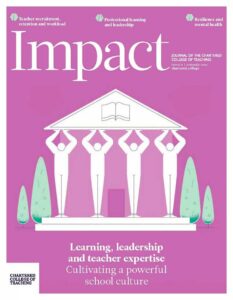Growing the Top: A case study of designing an approach to creating effective external partnerships

Conflict of interest statement: The authors of this case study work for Challenge Partners, an education charity who operate a paid membership model for schools.
Challenge Partners (2020) is a national learning network of almost 500 schools that supports collaboration between individual schools and within the education system as a whole. The organisation is built upon Professor Sir George Berwick’s principle of upwards convergence: a means of ensuring that ‘continual improvement is achieved in a sustainable way’ (Berwick, 2017, p. 2). There are two distinct parts to this (see Figure 1): firstly, reducing disparity for the schools at the bottom of the system by closing the knowledge gap, and secondly, ‘stimulating the top to rise higher so that the whole system moves on’ (Berwick, 2017, p. 2).

Figure 1: The upwards convergence principle
Developing a model to support school improvement and knowledge exchange
In 2018, Challenge Partners decided to create a bespoke programme that would focus on ‘Growing the Top’, by supporting school improvement and knowledge exchange among the highest-performing schools in the network. This case study focuses on our approach to designing and evaluating the programme.
Our approach to programme design was informed by a series of visit days conducted by experienced school leaders from Outstanding Schools, who were long-term partners in the Challenge Partners network during 2016–2017. These days demonstrated how beneficial it was for school leaders to visit other outstanding schools, and learn about what makes them systemically excellent. However, the initial structure of the days meant that hosts were sharing a lot with their visitors without necessarily being able to move along in their own school improvement journey. By focusing on the principles of collaborative learning, the programme team created – and piloted in 2017–2018 – visit day guidance, which resulted in a more balanced agenda that supported both visitors and hosts to leave each day with ideas for development.
The resulting programme, which ran in its pilot year in 2018–2019, consists of two parts. Firstly, the programme team facilitates visits to each of the participating schools in trios. Schools are matched so that there is geographical, contextual and school type diversityThe recognition of individual differences in terms of race, in each trio. This approach was chosen because it exposes leaders to approaches outside of their own sphere of familiarity, and supports the development of new professional relationships outside of existing local or regional networks. On the visit days, visitors from two schools can explore what makes the host school excellent at a systemic level, enabling them to glean ideas for improvement in their own schools. Additionally, host schools have the opportunity to explore areas of challenge with visiting colleagues, who offer a fresh perspective, question assumptions and share their own expertise and suggestions for dealing with the challenge.
Secondly, the programme brings the group of leaders together on three occasions over the course of the academic year, to hear from external speakers from the public sector, research institutions, the private and international education sector and the corporate world, who offer fresh ideas that challenge prevailing thinking and stretch school leaders’ imaginations.
Evaluating the programme
We commissioned research in 2018–2019 to evaluate how well the programme supported outstanding schools in learning from each other and continuing to improve. Although the ultimate impact of any school improvement programme can only be measured by looking at improvements to students’ educational outcomes, the evaluation demonstrated that, for participating schools, their involvement ‘had led without delay to [changes] through adopting or adapting to their own specific context, the great ideas and practice from schools in their trio or had influenced planning for implementation in September’ (Matthews and Killick, 2019, p. 5).
All participants commented on how their participation in the programme achieved what Hargreaves describes as the deep and effective external partnerships that are the basis of the self-improving school system (2010, 2012). Indeed, one participating trio commented to the evaluation team that:
“System-led improvement can really work: the way we were talking; the way we were taking ideas away, the way we really wanted to improve our own schools. That’s definitely a vehicle for the way forward.”
(Matthews and Killick, 2019, p. 33)
Challenge Partners’ Growing the Top programme demonstrates how a model of externally brokered, facilitated and quality-assured visits allows school leaders to fully participate by not shouldering any practical or logistical responsibilities for the day. Furthermore, the structure provides the opportunity for outstanding schools to meet and showcase best practice, as well as frankly exploring more intractable challenges, allowing the most outstanding schools in our education system to continue to improve and redefine what outstanding looks like.
References
Berwick G (2017) Upwards convergence. Available at: challengepartners.org/sites/default/files/files/CP-Upwards-convergence-brochure.pdf (accessed 16 January 2020).
Challenge Partners (2020) What we do. Available at: challengepartners.org/what-we-do (accessed 15 January 2020).
Hargreaves D (2010) Creating a self-improving school system. National College for School Leadership. Available at: assets.publishing.service.gov.uk/government/uploads/system/uploads/attachment_data/file/325873/creating-a-self-improving-school-system.pdf (accessed 17 November 2019).
Hargreaves D. (2012) A self-improving school system: Towards maturity. National College for School Leadership. Available at: assets.publishing.service.gov.uk/government/uploads/system/uploads/attachment_data/file/325908/a-self-improving-school-system-towards-maturity.pdf (accessed 17 November 2019).
Matthews P and Killick R (2019) Growing the Top – Extending Excellence in a Learning Community of Stand-Out Schools. London: Challenge Partners.










